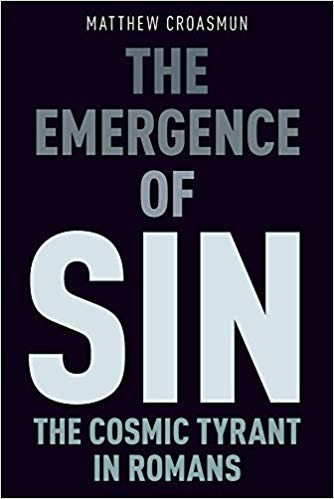Scot McKnight is an American New Testament scholar, historian of early Christianity, theologian, and author who has written widely on the historical Jesus, early Christianity and Christian living. He is currently Professor of New Testament at Northern Baptist Theological Seminary in Lombard, IL. The views expressed in this commentary do not necessarily represent those of BCNN1.
My review of a fantastic new book, now in paperback: Matthew Croasmun, The Emergence of Sin: The Cosmic Tyrant in Romans (New York: Oxford University Press, 2017).
Sin in the Pauline letters seems to be more than the violation of a command and seems to take on systemic force. Christian theology’s doctrines of original sin and guilt are but one example of theological attempts to come to terms with lower case sins and upper case Sin as a tyrant. In Matthew Croasmun’s recently published dissertation, The Emergence of Sin, a series of proposals are made that provide innovative solutions to all the above and more.
Croasmun establishes both the contours and parameters of the discussion in chapter one, which sorts out scholarship more or less into the individual or psychological (R. Bultmann), cosmic or mythological (E. Käsemann), and the systemic view of liberation theologians (E. Tamez). His terms are “sin came through sinning” (4), standing under definite dualism’s lordships (11), and sinful institutions (15). Croasmun’s contention is not that these elements are not each present, for they are, but that they can’t explain enough. Sin, what is it? Personification or a hyper reality? Is the individual sinning paradigm sufficient for the cosmology and anthropology at work? Is not Sin experienced as something outside and inside, as some kind of cosmic tyrant? What happens then to cosmology and anthropology? “We would prefer a reading that can hold together both sides of the contradiction, about which Bultmann and Käsemann more or less choose sides: that is, that human agents are subject to a power, Sin, that constrains their freedom to act; and that they are nevertheless responsible for their sin. Liberationist readers move us in the direction of being able to hold these two “sides” of the debate in tension, though not without introducing their own difficulties and limitations” (15). Whether it is social or cosmic forces, the systemic theory of Sin acting upon humans offers promise in coming to terms with the Pauline presentations in Romans. How then can Sin be explained as an enslaving force or power? Are the structures simply consequences of individual sins or do they take on a power of their own? What happens then to cosmology and anthropology? What is a person, or what is an agent? Is Sin a person or agent? Sin, Romans 7:8, makes clear is some kind of agent acting upon the person in his or her attempt to observe Torah.
The singular contribution of The Emergence of Sin is Croasmun’s lengthy, accessible and paradigm-altering proposal that sin by the individual, Sin as a cosmological presence and Sin as a systemic can be explained best by emergence theory. In chapters two and three the author examines emergence theory and personhood by appealing to the physical and social sciences as well as philosophy, sociology and psychology. His concern is “trans-ordinal theory,” or the relationship of various levels and how one is caused or correlated with another. Emergence is “concerned with the appearance of higher-order properties at coordinating higher levels of complexity” (23). The “wetness” of water, beehives, memory and money each briefly illustrate emergence that appears to be both caused by lower order elements yet taking on something of a life of its own. Dualistic theories are on their way out as some kind of ontological monism becomes more and more the scientific orthodoxy. Reductionisms are emergentism’s primary challenge: that is, the thought that lower levels always explain higher levels. However, “explain” and “explain away” are not the same thing. The mind does not exist apart from the chemicals at work in the brain, yet the mind and its intentions do real work in the world (hence, something like emergence is better than dualism or reductionism).
The core to Croasmun’s explanation of emergence theory itself is the dialectical relationship of supervenience and downward causation. Supervenience is not as intuitively clear as downward causation: the former refers to a causal basis of higher properties from which they emerge while the latter contends that what emerges works back almost in cyclical fashion upon the supervenience base making it more of what it is. They feed on one another and form one another. I shall enter our topic now into the discussion: human agents sin and from these sins, Sin emerges and Sin as an Agent works back on humans to precipitate more sin and sinning. Sin is ontologically dependent for its existence on human sinning. Croasmun’s ability to think through various systems of thought comes into play in these two chapters, each of which both demonstrates and illustrates this interplay of supervenience and downward causation. For example, the mind supervenes on the brain but the mind is not reducible to brain. Mind, thus, is more than brain.
Importantly, the question becomes Is the Mind then something other than brain? Croasmun examines this dialectic with amazing dexterity in chemistry, biology, sociology, and then focuses on racism. Back to sins and Sin: “In this light, the conflict between Käsemann and more radical liberationists, on the one hand, and Bultmann and the Vatican, on the other, is entirely predictable: it is the conflict between dualists and reductionists. Those more committed to modernist frameworks (Bultmann and the Vatican in this case) adopt the reductionist view. Those more committed, largely for theological reasons, to the recovery or preservation of premodern frameworks (Käsemann, Gaventa, etc.) adopt a dualist view. Those less committed to modern or premodern Western frameworks (non-Western liberationists and postmodern Westerners) are inclined toward something that looks more emergent” (55).
Source: Christianity Today
All Content & Images are provided by the acknowledged source
